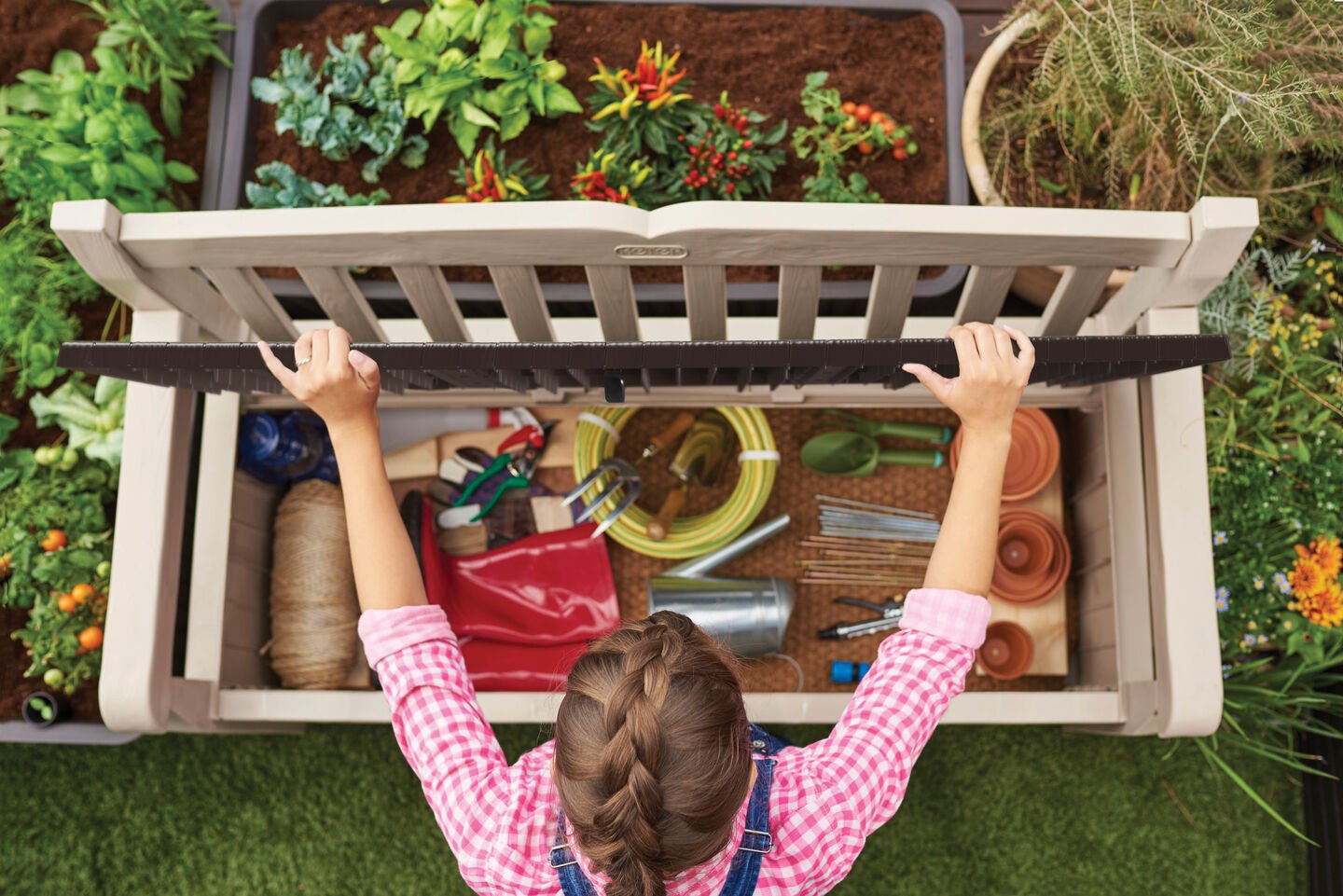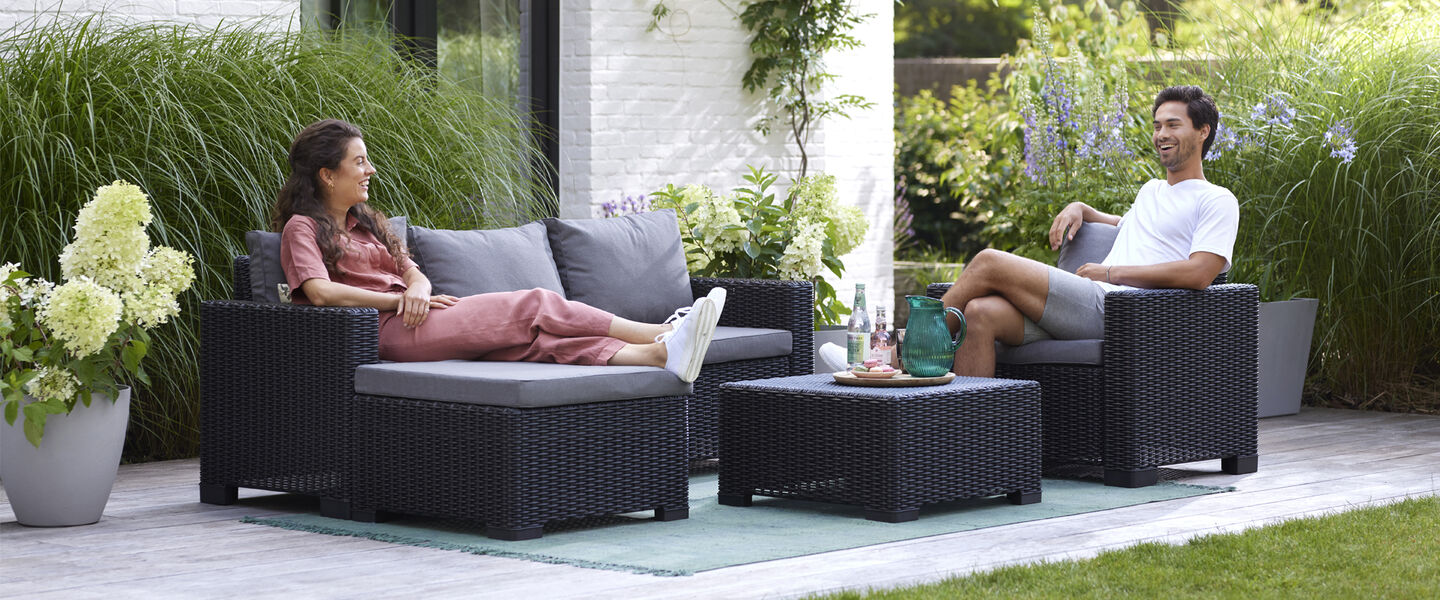
Jump on the garden zoning trend this Summer
What is a multi-functional garden and how do I get one?
A good garden is an extension of your living space – a place to relax, play, and hang out with friends and family. That’s where the multifunctional garden comes in – different zoned areas that cater for different moods, times of day or the needs of different family members.
Your multifunctional garden will give the kids their own special area to play in, the adults a place to unwind, and a place for the whole family to share time together. The other thing we love about this style of outdoor space is how great it is for enjoying hobbies – whether it’s reading, painting or planting.
The best way to get started is to carefully plan each zone, making sure they flow seamlessly together while maintaining their distinct identities. It’s all about maximising available space and transforming your outdoor area into a personalised, functional, beautiful summer sanctuary.
Now, let's explore some ideas for creating distinct zones within your multifunctional garden.
Serenity Zone
Transform a corner of your garden into a tranquil escape by creating a soothing water feature – or perhaps just a beautiful bird bath to attract the local songbirds. Try hanging wind chimes, and think about arranging some seating, specifically designed for comfort and unwinding. We recommend our Daytona Deluxe Sun Loungers for deep relaxation, or for something slightly more social, our California 3 Seater Chaise Longue’s simple design gives a clean, minimalist look.
The right greenery can add an extra touch of calm – fragrant plants like lavender and jasmine create a peaceful ambience – perfect for relaxation and meditation. If you feel like really going for it, you could add a pergola draped in lightweight fabric for a shaded retreat.

Tips for lavender planting
To plant and care for lavender, choose a sunny location with well-drained soil. Lavender thrives in full sun and doesn't like overly moist conditions. You can either plant lavender directly in the ground or in containers – this means you can move them around your garden as needed. When planting, space the lavender about 30cm apart for good air circulation. You don’t need to do much to keep them happy. Just water sparingly and prune annually to keep things under control.
Tips for jasmine planting
For jasmine, choose a location with full to partial sun and well-drained soil. Grow it as a climbing vine or shrub, depending on the species. If you want a climbing variety, make sure you have a trellis or fence (perfect for a zoning partition). Water your jasmine regularly, especially during the growing season, but allow the soil to dry out slightly between waterings.
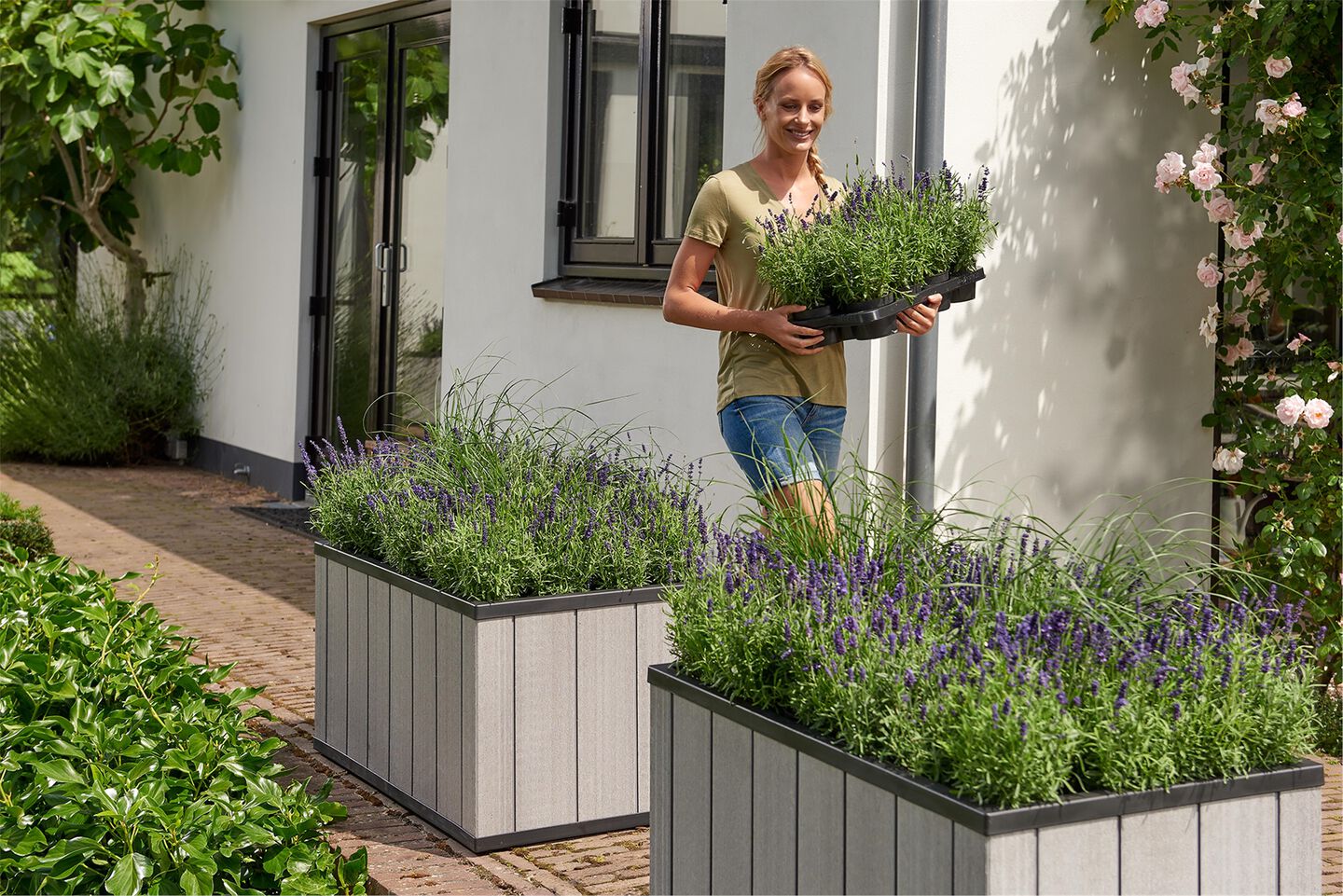
Nature zone
What could be more glorious than creating a lush, green nature zone, filled with ladybird houses, wildflowers and trellis dividers adorned with floral vines like passion fruit or honeysuckle? Add a hammock, swing seat, or one of our Eden Storage Benches and you’ll have a spot to settle into and watch all the wonderful wildlife. Even better – our storage benches not only look gorgeous, but you can secretly stash all your gardening equipment inside too.
Here are some excellent ways to boost your garden ecosystem and welcome wild species into your nature zone.
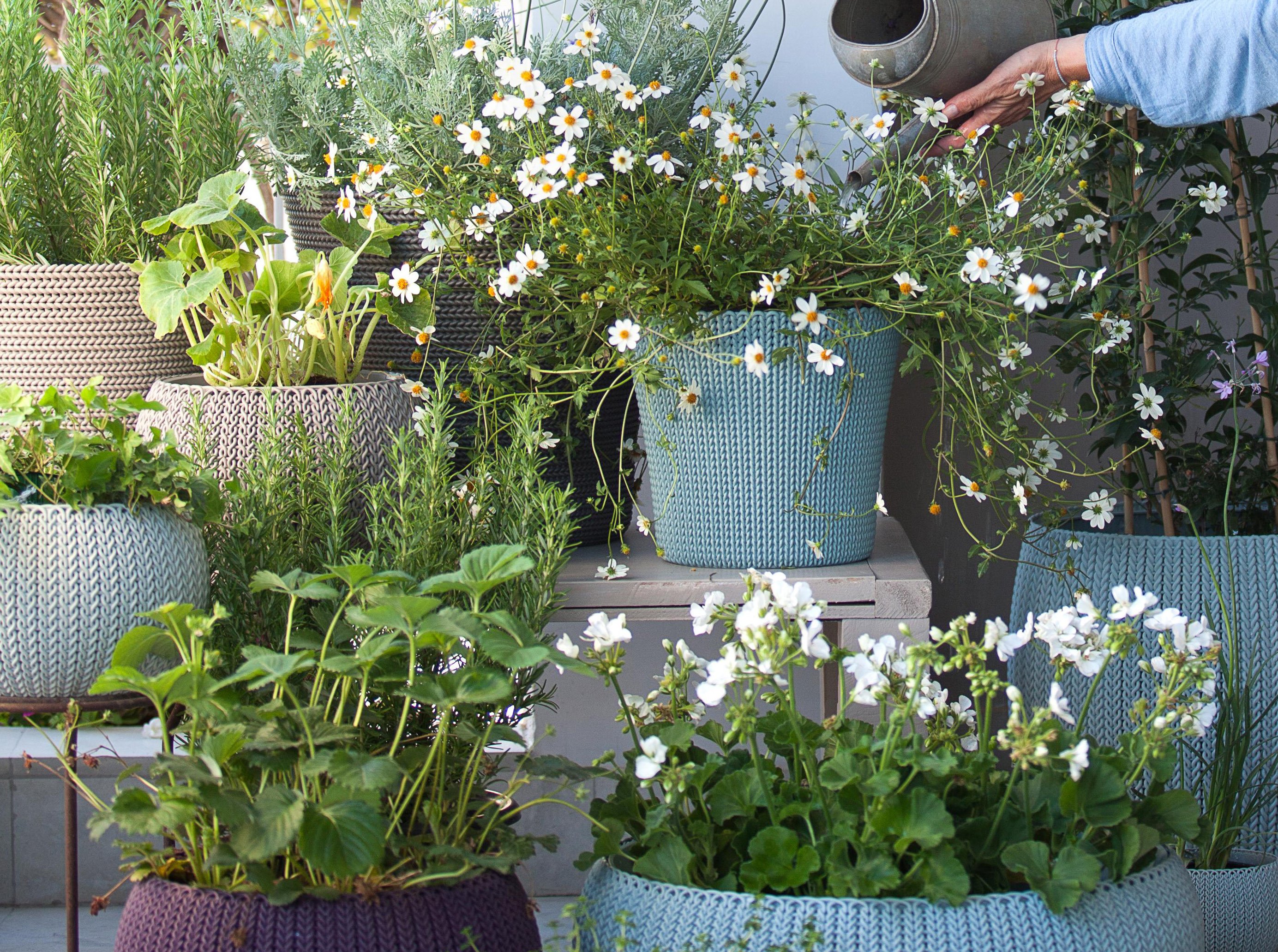
1. Food sources are a thing. Make sure you have a range of seeds, nuts and fruits in bird feeders. Different birds prefer to eat different dinners. It’s a good idea to plant nectar-rich flowers like a butterfly bush, echinacea and foxglove to attract pollinating butterflies and bees.
2. Create habitats. Birds and small mammals love nesting sites and places to shelter. You can install birdhouses, bat boxes and hedgehog homes to welcome them into your garden. Plant a variety of trees, shrubs, and groundcovers to offer protection and nesting materials.
3. Make sure your visitors have something to drink. A pond, fountain or bird bath are great water sources for drinking and bathing. Include flat rocks or shallow areas for amphibians and insects to access the water safely.
4. Plant native species. Choose plants that are native to your region, because they’ll create the best habitat and food sources for local wildlife. Native plants also need less maintenance, as they’re adapted to your area's climate and soil conditions.
5. Avoid using chemicals. Try not to use pesticides and herbicides in your garden – they can be harmful to both the wildlife and the environment. Instead, choose organic and natural pest control methods, like introducing friendly ladybirds and lacewings.
Kid's zone
Kids need an area for playtime and adventures, especially in summer. If you create a garden zone especially for your little ones, it gives them space to go a little crazy (and it helps you to manage the beautiful chaos). Our key must-haves for a kid’s zone are a playhouse, sandpit and swing.
You can also get super creative and build a children’s veg patch. It’s a great way for your kids to learn about gardening and it just might encourage them to eat more greens. If this sounds like a good idea, here are our top tips to get started.
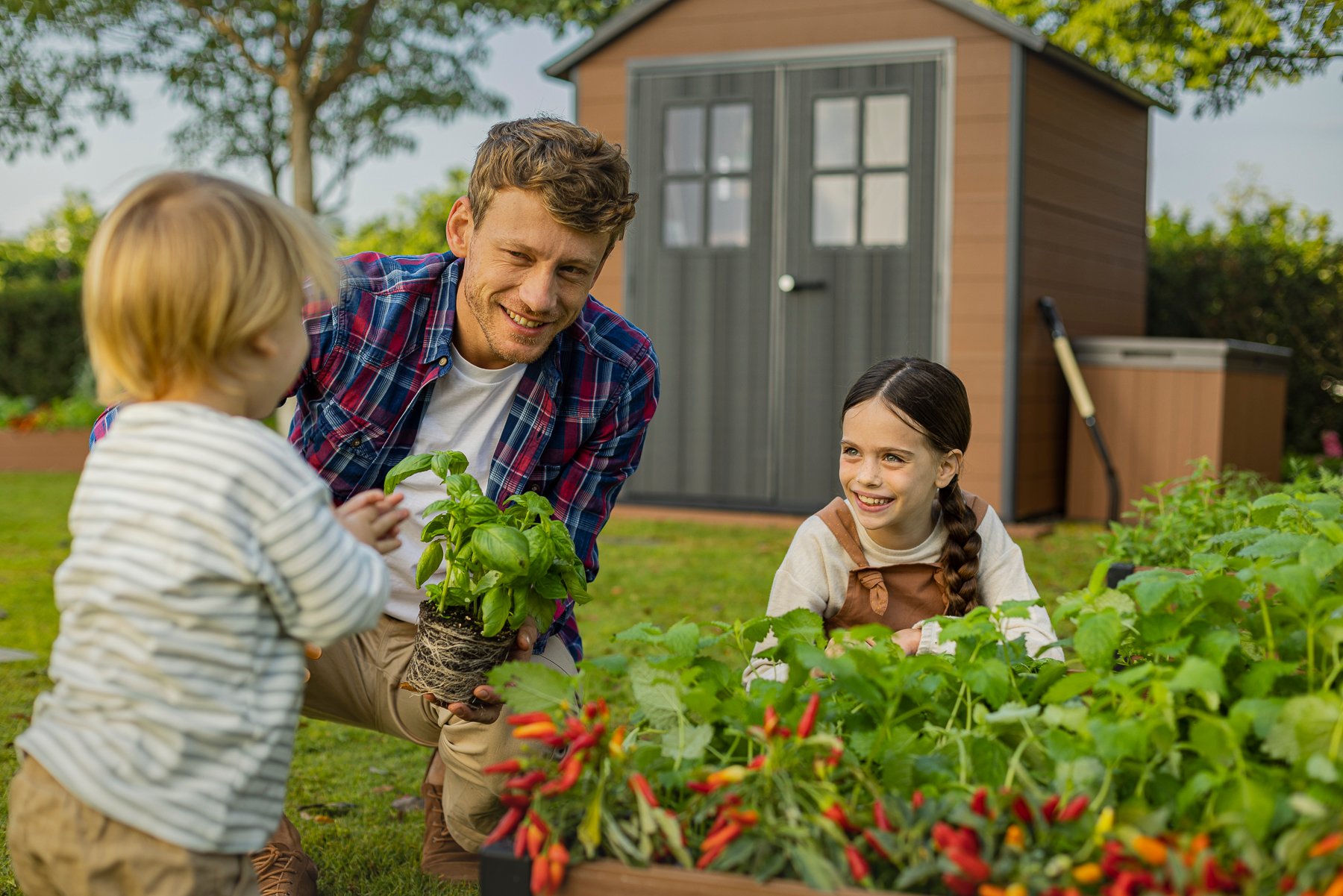
1. Build your kid’s veg patch in a sunny location. We like to use raised beds because it helps reduce the risk of unfriendly microbes from ground soil. Our Sequoia Elevated Garden Bed is nice and roomy, perfect for growing an abundance of simple veggies. And for something a bit more involved, we have the compact Maple Greenhouse – for growing more exotic varieties.
2. Let your kids choose the plants, veggies and seeds that you’ll grow and get them involved in preparing the soil. The more they feel like it’s their project, the more fun they’ll have.
3. This is a summer project, so you’ll need to focus on fast-growing, easy-care vegetables that’ll capture the interest of your little ones. Our favourite options are: radishes (harvested in as little as three weeks), cherry tomatoes (you could use the Keter Maple Greenhouse for these), lettuce (fast-growing and easily pickable for a quick kid’s sarnie), carrots (we like the smaller, speedy growers), and beans (pole beans or bush beans both grow nice and fast).
Garden reading zone
Carve out a secluded spot in your garden for a peaceful reading retreat. Choose a shady location under a tree or pergola, and furnish it with comfy seating like a plush outdoor armchair or a couple of our Everest Adirondack chairs with adjustable backs.
Surround your reading zone with lush greenery and fragrant plants – gardenias or lilacs, or any colourful potted flowering plants – to create a beautiful and calming space, perfect for settling into a good book. You could even add some soft outdoor lighting, like solar-powered lanterns or string lights, to extend your reading time into the evening.
And don’t forget the most important thing – a small side table to hold your current read and cup of tea (or Pimms). Our Cool Stool is just the thing if you want something elegant and compact – you can even store a few ice-cold beers inside. If you have enough space, you might add a small outdoor bookshelf or storage box, like our City Storage Box, to keep your favourite books inside. We make all our storage boxes from sustainable plastic – they’re designed to last and protect all of your precious things from the elements.
Open-air dining zone
This is all about creating a magical space for dining and entertaining. Somewhere to spend time with your family or invite your friends over for an open-air dinner party or barbeque.
The right furniture is a must, and we have tables and chairs to suit every outdoor space. Our Santiago sets seat from four to eight people – and you can always add more chairs for bigger parties.
Fairy lights are another must and you can never have too many. We like them above the table and around the walls. You can even weave them around colourful potted plants or nearby trees. Add a few plush cushions, a portable speaker and a fire-pit for cooler evenings and you have the perfect zone for entertaining.
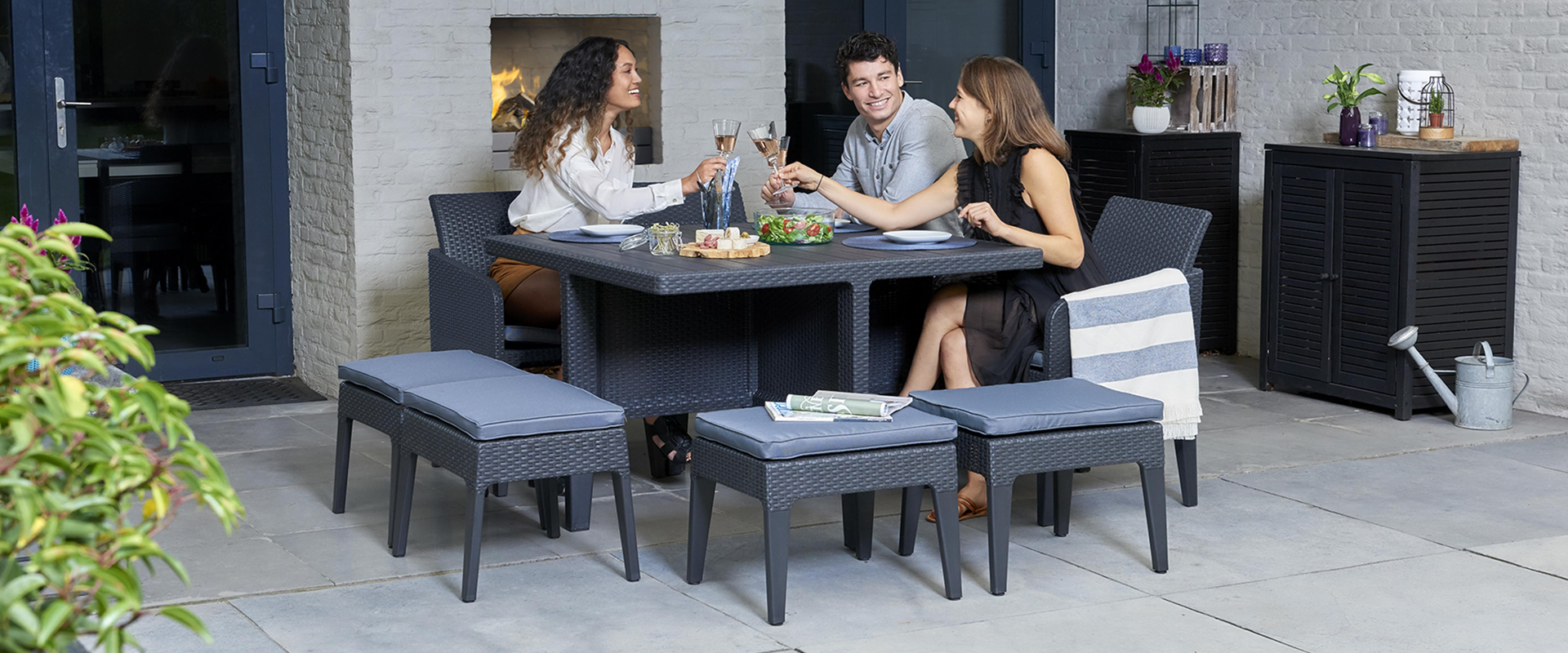
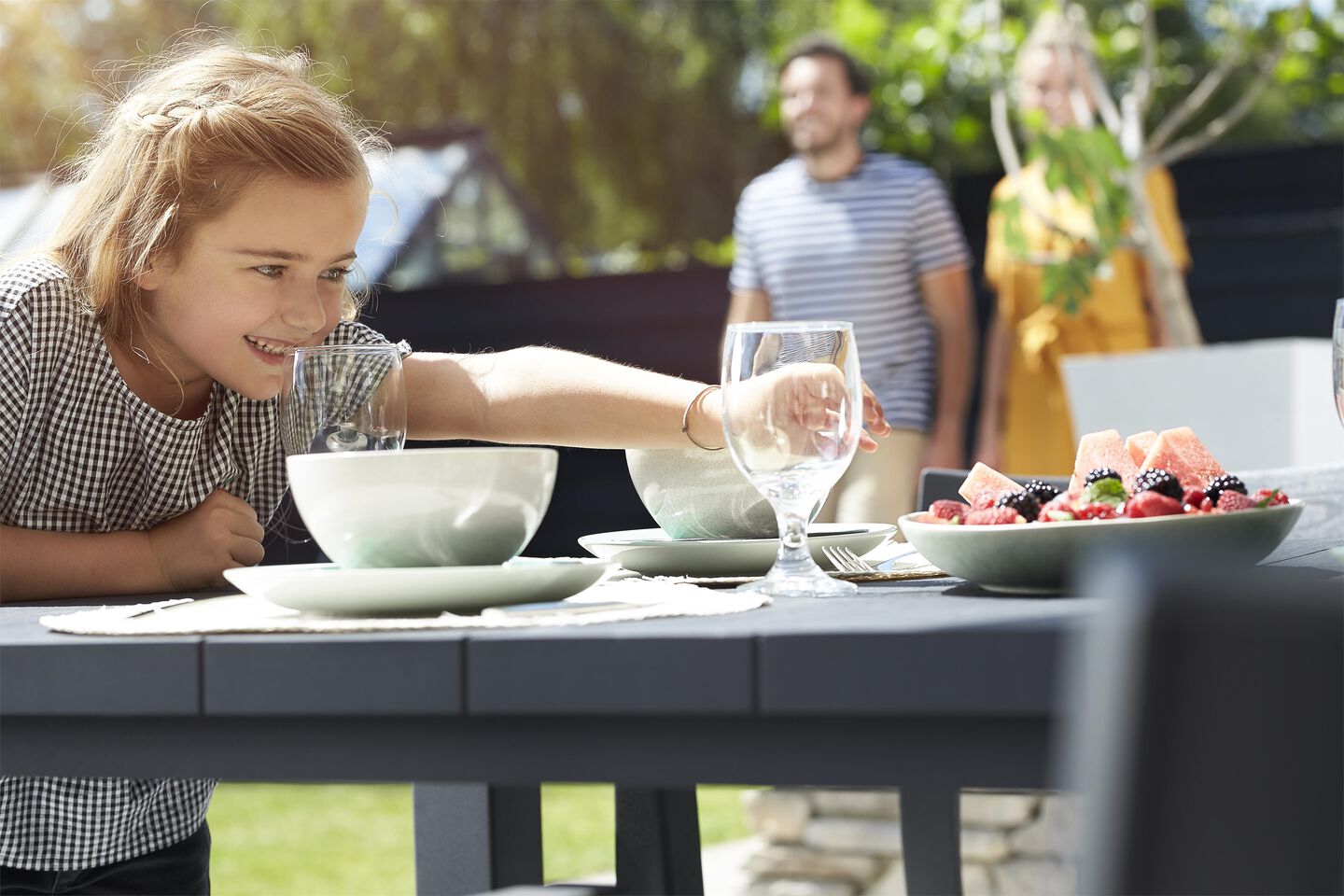
Here are our best tips for dressing your tables
1. Keep the table decorations natural. This is an outdoor space, so go with that vibe and choose neutral colours for your tablecloth and napkins. Decorate the centre of the table with wildflowers or glass dishes filled with shells – anything that comes from nature. You could even tie your napkins with daisy chains, especially if you have children on hand to help make them.
2. DIY cocktail station. Set up a special area for guests to create their own cocktails or mocktails. Lay on a variety of spirits, mixers and garnishes like fresh fruit, herbs, and edible flowers. Make sure you have enough ice and all the right equipment, including shakers and strainers, and don’t forget the recipe book. Keter’s Patio Cooler and Beverage Cart is a shortcut to creating the perfect cocktail station because it can house all the kit and keep the drinks cool.
4. Sundae bar – it’s not just for kids because we all know the adults will be just as excited. Stock up on a variety of ice cream flavours and toppings – chopped nuts, fruit, chocolate chips, candy pieces, that sort of thing. And sauces like caramel, hot fudge, and strawberry. Give everyone a bowl or sundae glass and let them start creating their own delicious sundae combinations. It’s a good idea to use a nice, big table for this kind of activity, and you can’t go wrong with one of our Metalea tables – perfect for setting up an extravagant feast of sweet treats.
We hope these ideas have inspired you to create your own summer zoned garden. Remember to make sure your zones are built around the things you love and how you like to spend your time. We’d love to see what ideas you come up with and how you’re using your outdoors spaces, so be sure to take lots of lovely pictures and tag us on Instagram, #KeterSpaces

We build in a sustainable manner.
We use innovative materials and leading technologies to build planet friendly products that last a lifetime.

